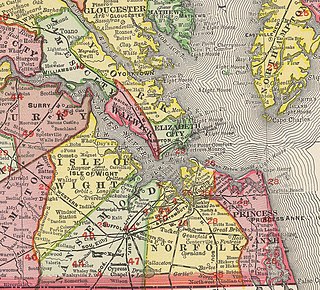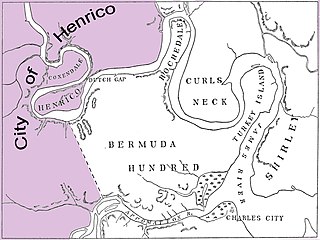
York County is a county in the eastern part of the Commonwealth of Virginia, located in the Tidewater. As of the 2020 census, the population was 70,045. The county seat is the unincorporated town of Yorktown.

The House of Burgesses was the elected representative element of the Virginia General Assembly, the legislative body of the Colony of Virginia.

Elizabeth City County was a county in southeastern Virginia from 1634 until 1952 when it was merged into the city of Hampton. Originally created in 1634 as Elizabeth River Shire, it was one of eight shires created in the Virginia Colony by order of the King Charles I. In 1636, it was subdivided, and the portion north of the harbor of Hampton Roads became known as Elizabeth City Shire. It was renamed Elizabeth City County a short time later.

The Virginia Peninsula is located in southeast Virginia, bounded by the York River, James River, Hampton Roads and Chesapeake Bay. It is sometimes known as the Lower Peninsula to distinguish it from two other peninsulas to the north, the Middle Peninsula and the Northern Neck.

Warwick County was a county in Southeast Virginia that was created from Warwick River Shire, one of eight created in the Virginia Colony in 1634. It became the City of Newport News on July 16, 1952. Located on the Virginia Peninsula on the northern bank of the James River between Hampton Roads and Jamestown, the area consisted primarily of farms and small unincorporated villages until the arrival of the Peninsula Extension of the Chesapeake and Ohio Railway in 1881 and development led by industrialist Collis P. Huntington.

Warwick River Shire was one of eight shires created in colonial Virginia in 1634. It was located on the Virginia Peninsula on the northern shore of the James River between Hampton Roads and the Jamestown Settlement.

Elizabeth City Shire was one of eight shires created in colonial Virginia in 1634. The shire and the Elizabeth River were named for Elizabeth of Bohemia, daughter of King James I.

Nansemond is an extinct jurisdiction that was located south of the James River in Virginia Colony and in the Commonwealth of Virginia in the United States, from 1646 until 1974. It was known as Nansemond County until 1972. From 1972 to 1974, a period of eighteen months, it was the independent city of Nansemond. It is now part of the independent city of Suffolk.
Lower Norfolk County is a long-extinct county which was organized in colonial Virginia, operating from 1637 until 1691.

County of Princess Anne is a former county in the British Colony of Virginia and the Commonwealth of Virginia in the United States, first incorporated in 1691. The county was merged into the city of Virginia Beach on January 1, 1963, ceasing to exist.

Charles City Shire was formed in 1634 in the colony of Virginia. It was named for Charles I, the then King of England, and was renamed Charles City County in 1637.

James City Shire was formed in the British colony of Virginia in 1634.

The City of Henrico is one of the oldest counties in the Colony of Virginia. It was one of four incorporations established in the colony by its proprietor, the Virginia Company. The City of Henrico, which included the settlement of Henricus, was the furthest incorporation upstream on the James River. In 1634, Henrico was reorganized under royal authority as the shire of Henrico, one of eight shires in the Crown Colony of Virginia, Later, it became known as Henrico County, Virginia.

The eight Shires of Virginia were formed in 1634 in the Virginia Colony. These shires were based on a form of local government used in England at the time, and were redesignated as counties a few years later. As of 2007, five of the eight original shires were considered still extant in the Commonwealth of Virginia in essentially their same political form, although some boundaries and several names have changed in the almost 400 years since their creation.
Ensign Washer or Ensign Thos (Thomas) Washer was an early Virginia colonist who settled in the area that became Isle of Wight County, Virginia. Washer and Christopher Lawne represented Lawne's Plantation as burgesses in the first assembly of the Virginia House of Burgesses, the lower house of the colonial Virginia General Assembly, in 1619.
Robert Savin was a member of the Virginia House of Burgesses, the elected lower house of the colonial Virginia General Assembly, from "Warrosquoyacke County," later Isle of Wight County, in the assemblies of 1629 and 1629–1630.
Samuel Sharpe, sometimes referred to as Samuel Sharp or "Ssamuel" was an early Virginia colonist who settled in the area that became Charles City County, Virginia. He came to Virginia in 1610 with most of the passengers and crew of the Sea Venture as they made their way to the colony after 10 months in Bermuda. They had wrecked in a storm there and built two small boats to complete their journey to Jamestown. Along with Samuel Jordan, he represented Charles City as a burgess in the first general assembly of the Virginia House of Burgesses in Jamestown, Virginia in 1619. He was a representative for Westover, an incorporation of Charles City, in the 1623/24 assembly and signed a letter along with several burgesses at the time of that assembly.
William Sharpe was an early Virginia colonist, soldier, ancient planter, and Virginia Company shareholder who settled in the Bermuda Hundred area that became part of Charles City County, Virginia. He served in the Virginia House of Burgesses in Jamestown, Virginia, in 1629.
John Pollington was an early Virginia colonist who was a member of the first assembly of the Virginia House of Burgesses at Jamestown, Virginia in 1619 for the "Citie" of Henricus, Virginia. In 1624, he was a burgess for Warrosquyoake Shire sometimes shown as Warresqueak and other variations, now Isle of Wight County, Virginia. He also was a landowner and merchant.






